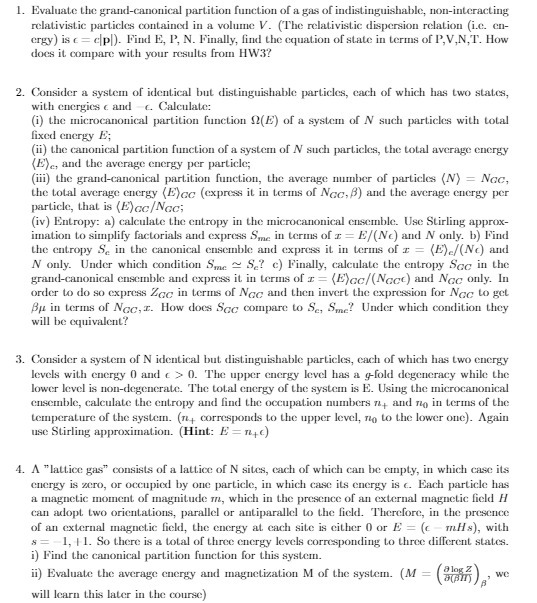
1. Evaluate the grand-canonical partition function of a gas of indistinguishable, non-interacting relativistic particles contained in a volume V. (The relativistic dispersion relation (i.c. en- ergy) is c = cp[). Find E, P, N. Finally, find the equation of state in terms of P, V,N, T. How does it compare with your results from HW3? 2. Consider a system of identical but distinguishable particles, each of which has two states, with energies c and -c. Calculate: (i) the microcanonical partition function ?(#) of a system of N such particles with total fixed energy E; (ii) the canonical partition function of a system of N such particles, the total average energy (E), and the average energy per particle; (iii) the grand-canonical partition function, the average number of particles (N) = Noc, the total average energy (F)ac (express it in terms of Noc, #) and the average energy per particle, that is (F)ec/Noc; (iv) Entropy: a) calculate the entropy in the microcanonical ensemble. Use Stirling approx- imation to simplify factorials and express Sme in terms of = = E/(Nc) and N only. b) Find the entropy S, in the canonical ensemble and express it in terms of z = (E),/(Nc) and N only. Under which condition Sme ~ 5,? c) Finally, calculate the entropy Sag in the grand-canonical ensemble and express it in terms of = = ()cc/(Noct) and Noc only. In order to do so express Zac in terms of Noc and then invert the expression for Nog to get Ap in terms of Noc, I. How does Sac compare to S, Sme? Under which condition they will be equivalent? 3. Consider a system of N identical but distinguishable particles, each of which has two energy levels with energy 0 and c > 0. The upper energy level has a g-fold degeneracy while the lower level is non-degenerate. The total energy of the system is E. Using the microcanonical ensemble, calculate the entropy and find the occupation numbers n, and no in terms of the temperature of the system. (n, corresponds to the upper level, no to the lower one). Again use Stirling approximation. (Hint: # =nc) 4. A "lattice gas" consists of a lattice of N sites, cach of which can be empty, in which case its energy is zero, or occupied by one particle, in which case its energy is c. Each particle has a magnetic moment of magnitude m, which in the presence of an external magnetic field H can adopt two orientations, parallel or antiparallel to the field. Therefore, in the presence of an external magnetic field, the energy at each site is cither 0 or E = (c -mis), with s = -1, H1. So there is a total of three energy levels corresponding to three different states. i) Find the canonical partition function for this system. ii) Evaluate the average energy and magnetization M of the system. (M= (apin ) 8 log Z we will learn this later in the course)








